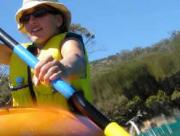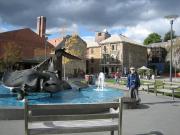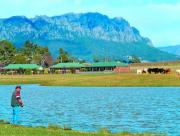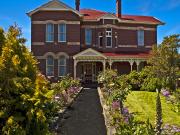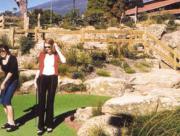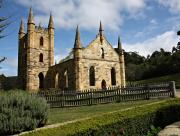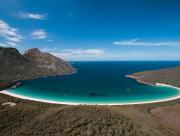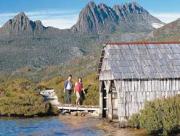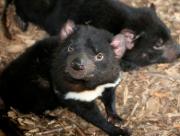Tasmania Attractions
There is a lot more to Tasmania than just rich heritage, stunning scenery, fertile wilderness, unique wildlife, gorgeous wildflowers and world class food and wine. There is an adventurous side of the state that few may realise with a range of activities that vary from gentle outdoor pursuits to something with a real adrenaline rush. Those with a sense of adventure can enjoy rafting, jet boating, diving, wilderness flights, horse riding, cruising, sea kayaking, abseiling/climbing, caving, cable hang gliding, cycling/mountain biking, all-terrain touring and much more!
The stunning surrounds of Tasmania are the perfect inspiration for the many talented and creative souls that flock to The Apple Isle. The unique rainforest timber is the ideal muse for the woodworkers, while painters seek to capture the patchwork of colours and soft light of the area. Photographers make the most of the stunning scenery wherever you point a lens and writers draw on the moody, wild landscapes. Salamanca Place in Hobart is home to galleries, shops, markets and working studios while Launceston's busy creative heart features galleries along the riverside. There are also a number of smaller creative communities worth visiting including Deloraine, Bothwell and Stanley.
Renowned for its trout fishing, it's difficult to recommend a particular location in Tasmania as trout are everywhere! The many streams in the north include the Mersey, Meander, Liffey, North and South Esk, Macquarie and Elizabeth while to the south and west there's Lake St Clair, Lake Burbury and Lake Peddar. The Central Plateau is also home to the luxurious London Lakes, one of the world's top five specialist angling lodges. The estuaries, bays and beaches are also full of bream, flathead, whiting and Australian salmon as well as big game fish like tuna and marlin.
Tasmania is a food lover's paradise with the mild climate, clean air, fertile soil and unspoiled waters surrounding the island yielding some of the best local produce available. Famous both locally and overseas for its fantastic seafood, Tasmania also produces some of the finest cheeses and beverages. There are more than 200 vineyards in the state which is also home to some of Australia's oldest breweries and most awarded ales. On Saturdays, the Salamanca Markets in Hobart offer a range of local produce including herbs, vinegars, mustards, bush honeys, organic goods, homemade condiments, smoked and fresh fancies, tender beef and lamb, the freshest vegetables, honeys, truffles, handmade chocolates and jellies.
Tasmania's fertile soil, clean air and mild climate ensure its banquet of blooms can be enjoyed year round. Tulips splash the landscape with colour while lavender pleasantly scents the air and ancient oaks and elms create a grand canopy. There are gardens showcasing plants unique to Tasmania's climate as well as the famous Royal Tasmanian Botanical Gardens in Hobart and Woolmers Estate National Rose Garden, a must see with over 5000 roses on display. Visitors are welcomed on guided tours of gardens, national parks and reserves where you can gain personal advice from garden experts and even stay in cottages surrounded by these stunning gardens.
There are over 80 golf courses in Tasmania with 11 major 18-hole courses including championship courses in the south such as Royal Hobart, Tasmania Golf Club, Kingston Beach and Claremont as well as in the north Launceston Country Club, Devonport and Ulverstone. There are plenty of unique 9-hole courses scattered throughout the state some of the most notable including Grindelwald (near Launceston) where gabled facades of a Swiss village surround the course, and the Tasman Club (near Port Arthur) with its challenging eighth hole requiring your tee shot to lob the ball onto a small green on the other side of a deep chasm that plunges hundreds of metres to the ocean below!
Tasmania is Australia's second oldest settlement with Hobart settles soon after Sydney however Tasmania's history pre-dates that by thousands of years. Aboriginal people inhabited Tasmania some 10,000 years ago and their carvings and artwork can still be seen on cave walls. After the first Europeans arrived in 1642, the English settled bringing convicts and soldiers who established farms and towns. There are many Georgian civic buildings that recall those grand eras as well as reminders of the convict days through hand-chiselled historic sites. The convict heritage is strongest on the Tasman Peninsula, the Old Hobart Gaol and Maria Island where the penal settlement pre-dates Port Arthur. A strong mining heritage is also present including Queenstown's still working mines and in the north east, Derby where you can pan for gems.
Over a third of Tasmania is protected in national parks and reserves and they are a delight to explore. There are 17 accessible national parks from the mountains to the coast as well as marine reserves and extensive working forests where you can kayak, take a leisurely bushwalk, ride a bike or even a horse. The Tasmanian World Heritage Area, the world's last great temperate wilderness, is made up of the Southwest National Park, Franklin-Gordon Wild Rivers National Park and Cradle Mountain-St Clair National Park. In total there are more than 2000 km of world-class walking tracks, thousands of highland lakes, hundreds of clean ocean beaches, extensive underground caverns and natural sculptures along the rugged coastline.
Tasmania is a compact state ad regarded as one of the world's best walking destinations. The smaller size of the island makes it easier to navigate and there are hundreds of walking tracks through a variety of landscapes which are all easily accessible. The mountains, beaches, coastline, rainforests, rivers and lakes all offer a great walking experience and because there are so many tracks to explore, they are never crowded. Due to its ever-increasing popularity, the facilities provided for walkers are superb - campsites, toilets, shelters, visitor centres as well as excellent quality tracks that are safe and well signed.
Tasmania is full of wildlife and, as much of it is nocturnal, exploring the wilderness for any critters that you can spot is a fun way to see the sights of Australia's smallest state. Mt William, Freycinet and the Narawntapu Parks are great for spotlight walks while Latrobe in the north west is one of the best places to see platypus in the wild. Mt William is also a haven for forester kangaroos, Tasmania's largest marsupials, which graze at dawn and dusk. Specialist wildlife tours are widely available and are highly recommended as they provide the best photo opportunities of wombats, quolls, the iconic Tasmanian devil and more!

